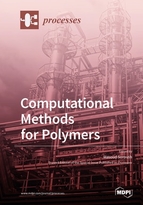Computational Methods for Polymers
A special issue of Processes (ISSN 2227-9717). This special issue belongs to the section "Materials Processes".
Deadline for manuscript submissions: closed (31 August 2019) | Viewed by 63975
Special Issue Editor
2. Department of Materials Science and Engineering, Drexel University, Philadelphia, PA 19104, USA
Interests: process systems engineering; polymer reaction engineering; electronic-level modeling of reactions; polymer membranes; renewable power generation and storage systems
Special Issues, Collections and Topics in MDPI journals
Special Issue Information
Dear Colleagues,
Advances in computational methods in the past decade have permitted the efficient reliable conduction of many complex tasks computationally (in silico). High-fidelity, multiscale, first priciples and entirely data-based mathematical models have been the backbone of the computational methods. The methods have allowed for the in-silico discovery of new materials, identification of new reaction pathways, determination and evaluation of optimal product synthesis steps, experimentation, and design of novel processes with improved energy efficiency and sustiability. They have also contributed to improving the real-time control and monitoring of processes. Polymers and polymer processes have also benfitted from these methods.
This Special Issue seeks papers that apply a computational method to a polymer, a polymer process and/or a polymerization reaction. Its scope includes modeling (from the electronic scale to the macroscopic scale), model-based product design, estimation, machine learning, data analytics, control, monitoring, optimization, numerical simulation, fault detection and identification, risk assessment, safety analysis, and model-based process design. Of particular interest are manuscripts that integrate experimental and computational studies.
Prof. Dr. Masoud Soroush
Guest Editor
Manuscript Submission Information
Manuscripts should be submitted online at www.mdpi.com by registering and logging in to this website. Once you are registered, click here to go to the submission form. Manuscripts can be submitted until the deadline. All submissions that pass pre-check are peer-reviewed. Accepted papers will be published continuously in the journal (as soon as accepted) and will be listed together on the special issue website. Research articles, review articles as well as short communications are invited. For planned papers, a title and short abstract (about 100 words) can be sent to the Editorial Office for announcement on this website.
Submitted manuscripts should not have been published previously, nor be under consideration for publication elsewhere (except conference proceedings papers). All manuscripts are thoroughly refereed through a single-blind peer-review process. A guide for authors and other relevant information for submission of manuscripts is available on the Instructions for Authors page. Processes is an international peer-reviewed open access monthly journal published by MDPI.
Please visit the Instructions for Authors page before submitting a manuscript. The Article Processing Charge (APC) for publication in this open access journal is 2400 CHF (Swiss Francs). Submitted papers should be well formatted and use good English. Authors may use MDPI's English editing service prior to publication or during author revisions.
Keywords
- Computational methods
- Polymers
- Multiscale modeling
- Estimation
- Control
- Optimization
- Detection and diagnosis
- Optimal control
- Inference
- Machine learning
- Data analytics






